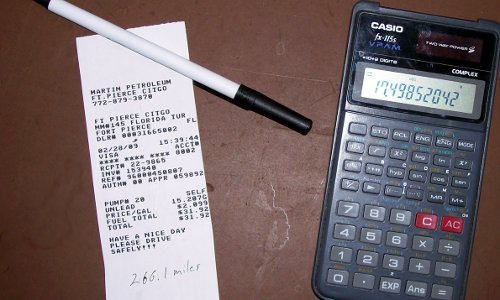Fuel Doctor Initial Test Results
Jason Lancaster | May 25, 2011 | Comments 1
>> Be sure to check our official Fuel Doctor review post to see if it really works!
Guest Post By Toby of Tundra Fuel Economy blog.
March 15th, 2011 – Prior to installation of the Fuel Doctor I was averaging 14.5 Miles Per Gallon for each tank of fuel. These numbers were firmly established over a period of several months. At the time of the commencement of testing I was refueling at one-quarter of a tank of fuel driving the same route seven days a week with unvarying weather and traffic conditions. In order to maintain consistent test conditions I used cruise control to and from work.

Punching Numbers - Fuel Doctor Testing
Immediately upon installation of the Fuel Doctor I recorded an increase of a little more than one and a half miles per gallon. The average per tank miles went from 14.5 MPG to 16.1 MPG – garnering an improvement of nearly ten percent. This improvement was phenomenal, but I viewed it with caution and reservation. Caution in that I questioned my accuracy and reservation in that I wanted to see this improvement sustained over a long period of time as well as miles and gallons. In previous testing of other products I have recorded initial gains only to see those gains wane and eventually disappear over the course of several tanks of fuel or a few thousand miles.
In addition to my concerns over the reliability of the initial data returns, I also had concerns as to if the Fuel Doctor was having an impact on the accuracy of my Scanguage. Since the Fuel Doctor claims to “smooth out” the electrical noise in my truck I wanted to be sure that it was not somehow affecting what my Scanguage was reading. I compared the average miles per gallon generated by the Scanguage against the results of the miles driven divided by the number of gallons pumped to full. The numbers have been dead on.
One strange anomaly I have noticed since the installation of the Fuel Doctor is that the miles per gallon actually go up a little while going uphill. Initially when beginning at the bottom of a grade, the MPG’s drop down as they usually do. But then, they bump back up by a couple of MPG’s. This happens consistently and is very interesting in light of the company’s claims both in terms of improving fuel economy through cleaning up the electrical signals in the vehicle. Is it possible that increasing engine load (climbing a grade) causes an increase in the variations in signals of the vehicle’s electrical system?
If so then it would appear that the Fuel Doctor does work in this circumstance. Even more interesting would be to test this with load such as a trailer attached or weight in the bed.
Current Data at time of this writing:
- Odometer 204,779 miles
- Average MPG 16.1 per tank as established from my residence to work and back
- Known maintenance issues still include a burnt front driver’s bearing – other than that truck is mechanically sound
- Gas used is limited to Marathon 87 octane from pump #6 on Michigan Road in Carmel, Indiana.
Search terms people used to find this page:
- tundraheadquarters
Filed Under: Toyota Tundra Accessories


I can try it to see if it helps me get 22mpg. With the mileage I have on my 07 is equal to a 6 or 7 year old vehicle.